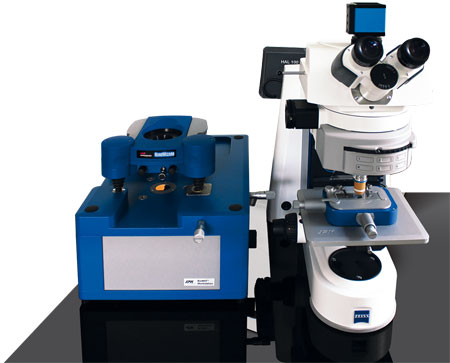Navigating the Atomic Force Microscope Market Landscape
 |
| Atomic Force Microscope Market |
The Atomic Force Microscope Market refers to the global
industry involved in the production, distribution, and utilization of atomic
force microscopes (AFMs). These advanced microscopy instruments are used for
high-resolution imaging and analysis of surfaces at the nanoscale level. The
market encompasses a wide range of AFM systems, accessories, and services
provided by key players in the scientific research, semiconductor, materials
science, and life sciences sectors.
The Atomic Force Microscope Market is estimated to be valued
at USD 602.4 Mn in 2024 and is
expected to reach USD 837.6 Mn by
2031, growing at a compound annual growth rate (CAGR) of 4.8% from 2024 to 2031.
The Atomic Force Microscope Market serves as a critical
technology hub for researchers, scientists, and engineers working in various
fields requiring nanoscale imaging and analysis capabilities. AFMs enable
precise imaging of surface topography, mechanical properties, electrical
characteristics, and molecular interactions at the atomic level, facilitating
research and development in nanotechnology, materials science, biology, and
semiconductor manufacturing.
Key Players
in the Atomic Force Microscope Market
Leading players in the Atomic
Force Microscope Market include renowned companies such as Bruker
Corporation, Keysight Technologies, Nanosurf AG, Park Systems Corp., and Oxford
Instruments plc. These key players specialize in manufacturing advanced AFM
systems, developing cutting-edge microscopy techniques, providing technical
support, and offering customized solutions to meet diverse research and
industrial needs in nanoscale imaging and characterization.
Market
Drivers for the Atomic Force Microscope Market
The Atomic Force Microscope Market is driven by several
factors, including increasing demand for nanotechnology research and
development, advancements in AFM technology leading to higher resolution and
accuracy, rising applications in semiconductor device characterization and
failure analysis, growth in materials science studies requiring nanoscale
analysis, and expanding use in life sciences for studying biological structures
at the molecular level.
PEST
Analysis of the Atomic Force Microscope Market
Political
Factors: Political factors influencing the Atomic Force Microscope
Market include government funding for scientific research and development,
regulatory policies governing nanotechnology and microscopy technologies,
international trade agreements impacting technology exports and imports, and
government initiatives promoting innovation in nanoscience and nanotechnology.
Economic
Factors: Economic factors such as research and development
investments, funding availability for academic and industrial projects, market
demand for AFM systems and services, pricing strategies for microscopy
instruments, and economic stability affecting customer purchasing power and
industry investments influence market growth and competitiveness.
Social
Factors: Social factors influencing the Atomic Force Microscope
Market include the adoption of nanotechnology in various industries, public
awareness and acceptance of nanoscale research applications, collaborations
between academia and industry for technology advancements, and educational
initiatives promoting STEM (science, technology, engineering, and mathematics)
fields and microscopy expertise.
Technological
Factors: Technological advancements in AFM systems, probe
technologies, imaging modes, data analysis software, and automation
capabilities drive innovation and competitiveness in the Atomic Force
Microscope Market. Integration of AFM with complementary techniques such as
scanning electron microscopy (SEM) and confocal microscopy expands application
possibilities and enhances research capabilities.
SWOT
Analysis of the Atomic Force Microscope Market
Strengths: The Atomic
Force Microscope Market's strengths include high-resolution imaging
capabilities, versatile applications in multiple scientific disciplines,
non-destructive and non-invasive imaging techniques, customization options for
specialized research needs, and continuous technological advancements enhancing
performance and functionality.
Weaknesses: Weaknesses
in the Atomic Force Microscope Market include high initial costs of AFM
systems, complexity in operating and interpreting AFM data for novice users,
limitations in imaging speed compared to other microscopy techniques, and
potential challenges in standardizing AFM measurements and calibration across
different instruments.
Opportunities:
Opportunities in the Atomic Force Microscope Market include expanding
applications in emerging fields such as nanomedicine, quantum materials, 2D
materials characterization, and environmental science, development of compact
and portable AFM systems for on-site measurements, integration of artificial
intelligence for automated data analysis, and collaborations for multi-modal
imaging solutions.
Threats: Threats to
the Atomic Force Microscope Market include competition from alternative
microscopy techniques such as transmission electron microscopy (TEM) and
scanning probe microscopy (SPM), economic uncertainties impacting research
funding and industry investments, potential regulatory hurdles in
nanotechnology applications, and intellectual property challenges in technology
innovations.
This comprehensive analysis provides insights into the Atomic
Force Microscope Market's dynamics, highlighting key players, market drivers,
PEST Analysis factors, and SWOT Analysis considerations. Stakeholders in
scientific research, nanotechnology, materials science, semiconductor industry,
and life sciences can leverage these insights for strategic decision-making,
technology investments, and market positioning in the rapidly evolving field of
atomic force microscopy.



Comments
Post a Comment